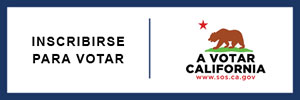Civic Engagement and Voter Empowerment
Register, Vote, and Volunteer
As part of our mission, we understand that voter empowerment and civic engagement is an essential part of the college experience and contributes to democratic participation in our society.
Through instruction, extracurricular activities, student clubs, internships, and peer-to-peer interactions, there are opportunities to become civically engaged and involved both on and off campus.
Our aim is to help demystify voter empowerment and civic engagement, and connect students with resources, services, and partnerships that will help them in their journey to become active and empowered global citizens.
Voter Empowerment
Important Dates
- Tuesday, September 16, 2025: National Voter Registration Day
- Monday, October 6 – Friday, October 10, 2025: National Voter Education Week
- Monday, October 20, 2025: Last Day to Register to vote for the November 4, 2025, Statewide Special Election
- Tuesday, October 28, 2025: Vote Early Day
- Tuesday, November 4, 2025: Statewide Special Election
Are You Eligible to Vote?
To vote in California, you must be:
- A U.S. citizen and a resident of California,
- 18 years or older on Election Day,
- Not currently in state or federal prison or on parole for the conviction of a felony. For more information, please see Voting Rights: Persons with a Criminal History.
- And, not currently found mentally incompetent to vote by a court. For more information, please see Voting Rights: Persons Subject to Conservatorship.
Get Started
To vote in California, you’ll need to be registered in California. Not registered yet, or not sure if you’re registered?
Translated Voter Materials
新選民 (Chinese)
नए मतदाता (Hindi)
初めて投票される方 (Japanese)
ចុះឈ្មោះបោះឆ្នោត (Khmer)
새 유권자 (Korean)
Magparehistro para Makaboto (Tagalog)
ผู้ลงคะแนนเสียงรายใหม่ (Thai)
Cử Tri Mới (Vietnamese)
Ensuring Participation: Increasing Voter Access
On a national scale, voter turnout has not surpassed 62.77% for a presidential election since 1960*. In this webinar, our campus student leaders explore the issue of voting access with elections experts – California Secretary of State Alex Padilla, State Senator Ben Allen. What is the state doing to encourage people to vote? How is California increasing voter access, including for vulnerable eligible voters who are homeless and/or disabled?
* “Voter Turnout in Presidential Elections – 1828-2016,” The American Presidency Project, UCSB.
Click on any of the FAQs below, which will guide you to the relevant California Secretary of State web pages. Use your state’s Secretary of State website as the primary source for elections and voting information.
- What is Same Day Voter Registration?
- Who is eligible to Pre-Register to Vote before age 18? And, how do I pre-register?
- Is there in-person early voting in my county? Where do I drop off my vote-by-mail ballot
- Where is my polling place?
- What is the California Voter’s Choice Act (VCA)?
- Does my county participate in VCA?
- How does California ensure access to Voters with Disabilities? Check out the following two videos:
- Watch on YouTube – Accessible Vote-by-Mail for Voters with Disabilities
- Watch on YouTube – Vote Centers and Accessibility
8. If an individuals have a primary language preference other than English, are voter registration applications available to them?
9. Does California provide the restoration of voting rights for individuals who have been formerly incarcerated?
Related Resources
For further research on related topics, here are a few resources.
National Conference of State Legislatures (NCSL) – Voter Registration
Provides an explanation of voter registration practices across states.
Center for Inclusive Democracy (CID) at USC Sol Price School of Public Policy
Demystifying Vote-by-Mail
In California, you may request a vote-by-mail ballot for a particular election or you may request permanent vote-by-mail status. California, along with 28 other states do this. Five states conduct all elections entirely by mail – Colorado, Hawaii, Oregon, Washington and Utah. Given Covid-19, what are the changes regarding vote-by-mail? Is it possible for California to follow in the footsteps of “all mail elections” states? How is California working with the U.S. Postal Service?
In this webinar, our campus student leaders address these questions with elections experts, California Secretary of State Alex Padilla, and Dr. Mindy Romero.
Frequently Asked Questions (FAQs)
Click on any of the FAQs below which will guide you to the relevant Secretary of State web pages. Use your state’s Secretary of State website as the primary source for elections and voting information. For more information, call the Secretary of State’s toll-free Voter Hotline at (800) 345-VOTE (8683) or contact your county elections office.
- How do I verify my voter registration status?
- How do I become a permanent vote-by-mail voter? Update your voter registration status to become a permanent vote-by-mail voter at RegisterToVote.ca.gov.
- How do I submit my vote-by-mail ballot?
- Once I’ve submitted my ballot, how can I track my vote-by-mail ballot?
- Will safe in-person voting be available?
- How do I apply to become an elections poll worker?
Cybersecurity and Election Interference
In 2016, national intelligence agencies confirmed that the Russian government interfered with the 2016 presidential election. This was done through propaganda created on social media platforms. No successful hacking of elections systems occurred. To prevent this from happening again and to prevent possible security breaches, Congress allocated $380 million in 2018 to help states strengthen their election cybersecurity. How has California used funding to strengthen the state’s voting system? What concerns were state elections officials addressing when they made their decisions?
In this webinar, campus student leaders explore election security issues with experts – California Secretary of State Alex Padilla, and Alliance for Securing Democracy’s David Levine.
Frequently Asked Questions (FAQs)
Click on any of the FAQs below which will guide you to the relevant California Secretary of State web pages. Use your state’s Secretary of State website as the primary source for elections and voting information.
- What is a provisional ballot? What happens after you cast it?
- What is a common misunderstanding about provisional ballots?
- How can you check the status of your provisional ballot by phone or online?
- Where are the safe in-person voting locations in my county?
- What is the Office of Election Cybersecurity and Enterprise Risk Management?
- How is California working with national intelligence agencies to improve election cybersecurity?
7. How are elections secured in California in all phases of the elections process?
8. What is California doing to curb election misinformation – Vote Sure Initiative, Vote Safe Portal?
9. In addition to voting, how can voters help combat elections misinformation?
Related Resources
Research and studies that are mentioned in the webinar can be found here. For accurate and timely information, we recommend that you begin your research here.
- National Association of Secretaries of State (NASS) – #TRUSTEDINFO2020
- U.S. House of Representatives, Committee on Homeland Security
- Alliance for Securing Democracy (ASD)
- David Levine Testifies before House Homeland Security’s Subcommittee on Cybersecurity, Infrastructure Protection, and Innovation (Aug. 4, 2020)
- ASD & the Bipartisan Policy Center – 20 for 20: 20 Ways to Protect the 2020 Presidential Election (May 20, 2020)
4. National Conference of State Legislatures (NCSL) – State Statutes Prohibiting Tampering with Voting Systems
Use the non-partisan resources below to learn about your representatives, candidates, ballot measures, and more.
Find Your Representatives
California Legislature
You are represented by one (1) Assembly Member and one (1) State Senator:
U.S. Congress
You are represented by one (1) House Member and two (2) U.S. Senators:
Your Ballot
Candidates
- Vote Smart – The Voter’s Self-Defense System
Civic Engagement
County elections officials depend on reliable, dedicated teams of poll workers to make every Election Day run smoothly. Apply at the Secretary of State’s Vote Safe California Poll Worker Portal.
Who can be a poll worker?
- A registered California voter
- A legal resident of the United States who would be eligible to vote except for their citizenship status
- An eligible high school student
What does a poll worker do?
- Sets up and closes a polling place
- Helps voters understand their rights
- Protects ballots and voting equipment
Why be a poll worker?
- Get involved and assist voters
- Contribute to your community
- Earn extra money (amount varies by county)
Understanding the November 4, 2025, Statewide Special Election
What is Proposition 50?
Put on the Ballot by the Legislature: Proposition 50 (Prop 50) seeks to replace California’s current congressional district maps with new legislatively drawn maps. If Prop 50 passes, the state would use Prop 50’s maps for congressional elections starting in 2026. The state would use these congressional maps until the California Citizens Redistricting Commission (Commission) draws new congressional maps, following the 2030 U.S. Census.
What Does a YES Vote on Prop 50 Mean?
A YES vote on this measure means: The state would use new legislatively drawn congressional district maps starting in 2026. California’s new congressional maps would be used until the Commission draws new maps following the 2030 U.S. Census.
What Does a NO Vote on Prop 50 Mean?
A NO vote on this measure means: Current congressional district maps drawn by the Commission would continue to be used in California until the Commission draws new maps following the 2030 U.S. Census.
Important Dates and Deadlines
All California active registered voters will receive a vote-by-mail ballot for the November 4, 2025, Statewide Special Election. To check your voter registration status, visit voterstatus.sos.ca.gov.
- Tuesday, October 7: Ballot drop-off locations opened.
- Vote-by-mail ballots can be returned by mail, at a drop-off location, or to your county elections office. To find a location, visit caearlyvoting.sos.ca.gov.
- Monday, October 20: The last day to register online to vote for the November 4, 2025, Statewide Special Election.
- Tuesday, October 21 – Tuesday, November 4: Same-Day Voter Registration (Conditional Voter Registration) is available. Voters can use the Same Day Voter Registration process during this time.
- Saturday, October 25: Vote centers open for early in-person voting in all Voter’s Choice Act counties.
- Tuesday, November 4: Election Day — Polls are open from 7:00 a.m. to 8:00 p.m.
- Vote-by-mail ballots must be postmarked on or before Election Day and received by November 12, 2025.
For more information on the November 4, 2025, Statewide Special Election, please visit vote.ca.gov or view the state voter information guide.
Get In Touch
Natalie Rodriguez
Director of Student Activities and Campus Life
nrodriguez@peralta.edu


